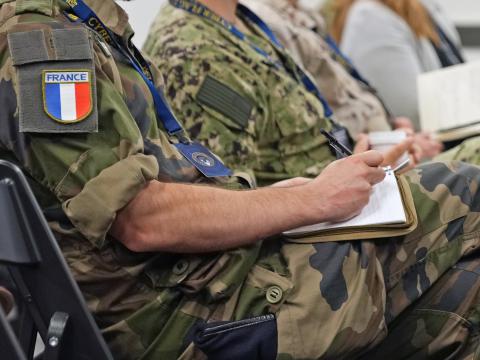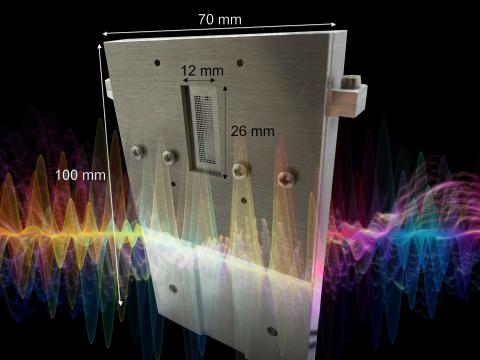Tactical Communication System Tuned for Export Market
Interoperability needs, advancing frequency requirements drive latest radio designs.
The advent of increasingly sophisticated threat organizations as well as the need to interoperate with technologically mature militaries are impelling many nations to acquire highly capable communications systems that are available from only a few sources. One system, the PRC2100V Spectre V, is the latest in a series of tactical voice and data communications systems and was designed primarily for use by countries in Asia, Africa and Latin America as well as in emerging markets in Central and Eastern Europe.
With this product, budget-conscious military and police forces can now procure tactical radios that offer most of the features of late-model high-end units such as the single channel ground and airborne radio system (SINCGARS), with the addition of display screens and messages in the native language of the user.
Bosnia and Herzegovina became the product’s first customer when it recently selected Spectre to satisfy the tactical very high frequency manpack requirements of its military under the U.S. State Department’s “train and equip” program. Deliveries are scheduled to begin this spring.
Spectre is manufactured by Datron World Communications Incorporated (DWC), which is a division of Datron Systems Incorporated, Escondido, California. DWC manufactures and distributes a line of very high frequency (VHF) and high frequency (HF) radio products and communications systems for government, military and industrial use in more than 120 countries. The division also manufactures and distributes a line of data handling systems that satisfies a range of requirements, from professional applications to full military configurations. In addition, DWC designs and implements complete communications systems for a variety of government and military customers.
According to John Winn, vice president of sales and marketing, approximately 90 percent of DWC’s business is in the international marketplace, primarily with military and government customers. On the domestic side, the company provides communications equipment to the State Department (for example, the Africa crisis program), to various U.S. government agencies for drug interdiction programs, and to U.S. Special Forces and signal units for specific applications.
“Our approach has always been to provide ‘best value’ alternatives to tactical communications equipment in the VHF and HF arenas,” Winn declares. “Our customers are primarily military and government organizations, police forces, emergency response units and similar organizations. Historically, most of our business has been in Asia and Africa as well as in Latin America where our customers are usually very cost conscious and want to maximize their investments.”
The company’s military and government customers in Asia have included such countries as Bangladesh, China, Indonesia and Sri Lanka; African customers include Algeria, Angola and Botswana; and Latin American customers include Brazil, Colombia, Mexico, Peru and Venezuela. In Europe, the company recently provided shelterized communications systems in a turnkey environment to the Greek army, according to Winn, as well as other communications equipment to Bulgaria.
In addition to providing very competitive prices for its equipment, company officials believe that a major success factor for DWC has been its ability to manage the risk associated with doing business in some of these markets. “It can be very challenging at times, and it requires a lot of patience and a lot of understanding of the market in which you’re working,” he explains.
The firm is increasingly turning its focus to new markets in these areas and to countries in Eastern Europe and the former Soviet Union. “We try not to develop or position products against the competition as much as we try to position them for a market focus or market opportunity,” Winn says. “We believe that Spectre and its follow-on products currently under development will allow us to continue serving our traditional customers. However, they will also allow us to move into some new market opportunities where perhaps we haven’t been able to compete in the past, such as Eastern Europe and niche areas in [North Atlantic Treaty Organization] NATO countries,” he adds.
“Defining who our competitors are depends on which region of the world you look at,” Winn explains. “Harris [United States], Thomson [France], Racal [United Kingdom], and Tadiran [Israel] are our principal competitors as well as Rohde & Schwartz [Germany] in some instances in the HF arena.”
The PRC2100V Spectre V provides voice and data communications in single-channel or frequency-hopping modes over the entire 30- to 88-megahertz frequency band, with both 25-kilohertz (2,320 channels) and 12.5-kilohertz (4,640 channels) spacing, according to DWC marketing director Michael Morris. It has 100 preset channels, each of which can be individually configured, and any or all of them can be placed in up to 10 different communications networks for battlefield applications, Morris adds.
The radio is designed to automatically accommodate data input either synchronously or asynchronously at rates ranging from 300 to 57,600 bits per second. Data can be transmitted in any one of the radio’s operating modes: clear channel, fixed frequency secure, frequency hopping or frequency hopping secure. Spectre is completely shielded from electromagnetic interference, and its high-dynamic-range receiver allows it to be collocated with other radios in tactical vehicles and command shelters.
Probably the most notable architectural feature of Spectre is its completely software-driven radio, which enables all future upgrades to be made using mini personal computer cards. According to Morris, this approach was adopted “to provide the maximum flexibility possible for our customers for upgrading and integrating the VHF radio with the future HF and multiband Spectre radios, while lowering the cost of ownership.
“Another major design consideration in the development of Spectre was interoperability,” Morris adds. The system is interoperable with previous generations of NATO-compatible radios, such as the AN/PRC-77, in either clear or ciphered modes. It is also fully compatible with later-model fixed-frequency VHF/FM radio equipment such as DWC’s PRC1077 manpack and PRC1060/70 squad radios. The system is completely interoperable with the company’s PRC1080 handheld and PRC1088 manpack radios in electronic counter-countermeasure (ECCM) and communications security (COMSEC) modes of operation, and it includes paging capability with these radios. Spectre also comes with an embedded 12-channel global positioning system (GPS) receiver that shows the local operator the time and position coordinates, and can transmit that information to a central site.
According to Morris, the latest version of Spectre V contains proprietary advanced data algorithms that can be tailored for user-specific requirements. They have three embedded levels of forward error correction to maximize throughput under jamming conditions. “Spectre has an extremely high probability of error-free transfer under severe battlefield conditions,” Morris claims.
The large full-graphic display is easily readable in direct sunlight. In addition, operation in the user’s native language is possible through a language independent design, which company officials claim is a unique feature among all tactical radio systems on the market. A five-language package is standard with the radio, but other languages are available as options.
“One of the strong points of Spectre is the user interface,” Morris states. “It is a completely menu-driven radio that allows operation in five different languages, and we designed it so that if you could operate a television remote control, you could easily operate Spectre V.”
The radio also contains a remote-control protocol that allows it to be operated completely from a computer or from an adjacent remote-control device. “There are three sets of menu screens,” Morris says. “The basic operator screen allows the operator to change the volume or channels and view the GPS position and time data. The programming and diagnostic screens, which are used by maintenance personnel, can be blanked out so that users can have access only to the basic operating screen.”
“We intend to continue evaluating and improving Spectre over time,” Winn says, “particularly regarding new ‘flavors,’ like the high frequency H version, or a multiband version, or whatever else we might choose. Our expectation is that, while we feel we have a great radio for our markets today, we feel that our development path for Spectre is going to continue improving its overall architecture and technical capabilities,” he adds.
According to Morris, the HF version of Spectre will be available at the end of this year and will operate in the 1.6- to 30-megahertz frequency range. It will share the same processor, operating system, chassis, front panel, battery set and accessories as Spectre V.
In addition to Spectre V, the company manufactures a line of tactical VHF/FM radios, including the PRC1077 and PRC1088 manpack models and the PRC1060/1070/1080 handheld models. Like Spectre, these radios are designed to provide reliable voice and data communications over the entire 30- to 88-megahertz range. System choices include “stack” mount configurations for fixed-station and shelter environments as well as manpack, mobile-mount and jerk-and-run setups for field operations.
All VHF/FM configurations are totally interoperable and can be used in a common network. Common frequency plans, common hopping and encryption keys can be loaded into the radios, which permits multiple transceiver types to be deployed as needed on the same mission in single or multiple networks. Orthogonal hopping in secure radios allows adjacent networks to use the same hopset of frequencies without mutual interference.
The entire line of radio equipment conforms to military standard (MIL-STD)-810E for shock, vibration, drop, immersion, sand and dust exposure, which allows them to be operated in the harshest tactical environments. The vehicular configurations are compatible with the AN/VIC 1/2 intercom set and meet both MIL-STD-1275 and applicable parts of MIL-STD-461A for operation in a variety of vehicles and sensitive situations.
The PRC1077 tactical VHF manpack radio was designed as a solid-state drop-in replacement for the AN/PRC-77 and VRC-12 radios. This allows users to modernize their tactical communications systems without making their existing inventories of accessories and ancillary equipment obsolete, according to company officials. It is fully interoperable with both the AN/PRC-77 and SINCGARS radios in all nonhopping and nonsecure modes.
The radio features a high-performance receiver, a wide temperature range display, 10 preset memory channels, a broadband transmitter with three unique operator-selectable power levels, and it can accommodate an internal voice privacy module to allow secure communications. It has a modular, open-architecture design that has allowed incorporating numerous upgrades since it was first introduced.
The PRC1088 radio system, developed in the mid-1980s and completely upgraded in the early 1990s, was the company’s original frequency-hopping digital-friction radio, according to Morris. It is available in manpack, vehicular and fixed-station configurations for a wide variety of mission requirements. It is fully compatible with the AN/PRC-77, PRC1077 and PRC1060 in fixed-frequency modes, and with the PRC1080 squad radio in fixed-frequency, hopping and secure modes.
The radio operates over nine preset channels in four modes: fixed frequency, fixed frequency secure, frequency hopping, and frequency hopping secure. It is capable of full retransmission in all modes along with ECCM/COMSEC. It also has up to eight frequency plans (interlaced to provide orthogonality) containing up to 2,320 programmable channels, which allow automatic “late entry” into 800 hopping nets. Both voice and data can be encrypted using the embedded encryption capability, which combines digital techniques and an algorithm that uses random start vectors and special key variables. The radio also has a two-level built-in test equipment (BITE) system that can isolate faults both at the unit level and at the module level using a more detailed series of tests.
The PRC1060, 1070 and 1080 2-watt handheld squad radios provide tactical communications with full coverage of the 30- to 88-megahertz band in 25-kilohertz steps. All three models have 2,320 available channels with nine fixed-frequency memory channels and use Motorola’s Saber battery to provide a 12-hour mission life. Company officials assert that, because of the minimal controls and simple, intuitive, menu-driven operator interface, these radios are easily used by even unskilled operators.
The radios have an internal BITE function that allows module faults to be quickly identified. All test and pass/fail data is shown on the easy-to-read front-panel display. They can also be mounted in vehicles using a docking station or a mobile mount to provide additional power, battery charging and remote-control interfacing.
The basic PRC1060 radio has operator-selectable options, including RF output (10 milliwatts to 2 watts), voice-processing enhancement for special network requirements, and low-level voice scrambling. It is designed for single-channel-only, fixed-frequency operations, making it interoperable with the PRC1077, but it cannot be upgraded to a PRC1080.
The PRC1070 model is identical to the PRC1060 but can be upgraded to a PRC1080 with the addition of an ECCM/COMSEC card, allowing for full frequency hopping with embedded encryption. This upgrade also provides complete interoperability with the PRC1088 manpack radio.
The PRC1080 is specifically designed for secure communications in a squad mission environment. It has internal full-band frequency-hopping and high-level digital encryption capabilities in either handheld or mobile configurations at power levels that range from 100 milliwatts to 35 watts.
The company’s HF line of professional and tactical transceivers, accessories and ancillary equipment can be configured to serve a variety of voice and data applications. The 125-watt 7000-series transceivers, which operate in the 1.6- to 30-megahertz frequency range, are available in a professional model, a rugged immersible package and a transportable “flyaway” configuration. They include embedded digital-signal-processing-based voice enhancement and high-level encryption. Peripheral devices and accessory equipment include 400-watt and 1000-watt RF amplifiers, automatic antenna tuners, full-function remote-control units and power supplies.
The RT7000 is a ruggedized long-distance HF transceiver that can be used in mobile, rack-mount and stack-mount configurations for voice and data systems of up to 1 kilowatt, using either broadband or narrowband antenna systems. It has 256 preset memory channels and operates in all standard modes, including upper sideband (USB), lower sideband (LSB), continuous wave keying (CW) and amplitude modulation equivalent (AME). It also comes with embedded high-level encryption and digital-signal-processing-based voice enhancement, and special data filters can be added to the standard transceiver.
The TW7000 series is a long-distance voice and data transceiver system that uses multiple microprocessors, digital signal processing and direct digital synthesis, and provides built-in features that include automatic link establishment, voice enhancement and encryption. It operates in all standard modes, including USB, LSB, CW, personal communication system (PCS) and AME, and a wideband data option is provided for high-speed data capability.
The company also manufactures the PRC1099A manpack radio that operates in the 1.6- to 30-megahertz frequency range. This 20-watt tactical radio can also be used as the core radio of vehicular and fixed-station systems with power outputs that range up to one kilowatt. The PRC1099A is designed for single sideband (USB and LSB) operation on voice, CW and data, including radio-teletype, acknowledgement request and burst modes of operation. Its filters have a reduced group delay, which makes them compatible with higher-speed HF modems and SSB speech encryption equipment. The transceiver is rated for 20-watt output in all modes.



